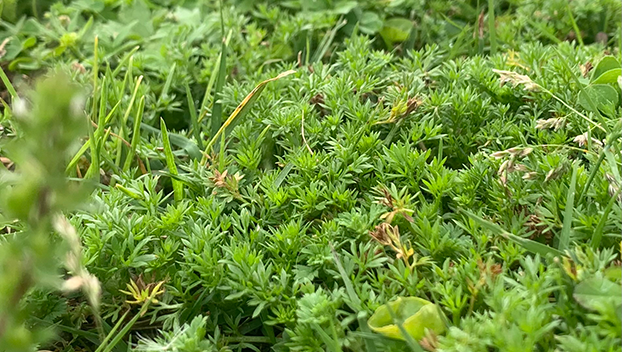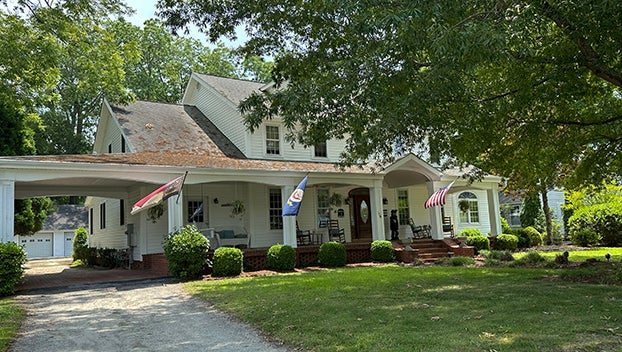How to avoid burweed and protect turf this summer
Published 3:55 pm Wednesday, May 5, 2021

- Photo submitted by Gene Fox.
|
Getting your Trinity Audio player ready...
|
I workout with a group called F3. The three F’s stand for Fitness, Fellowship, and Faith. We have our workout that takes care of our fitness. We have fellowship after the workout and sometimes at Taco Tuesday. The faith part comes during our Bible study once a week and after every workout. We have a circle of trust after every workout that is complete with announcements, prayer requests, and a prayer. F3 recently launched a new group in Plymouth. Upon finishing the very first workout and taking a knee, I heard plenty of complaining. I believe all 36 of the guys working out stuck their knees in lawn burweed.
Lawn Burweed is a winter annual weed that grows unnoticed until the spiny seed begins to form in the spring. This weed germinates in the fall, lies mostly dormant through the winter, and then grows like crazy when the weather gets warm in the spring. It grows prostrate along the ground so mowing is largely ineffective. By the time the spiny seeds come out, the plant is nearly through its life cycle for the year. At this point, herbicides are completely ineffective as well.
There is something you can do however, perhaps a little unorthodox and certainly not University researched, unbiased information, just good old-fashioned common sense. Get a fuzzy blanket and a couple of cinder blocks, which can be used for exercise too during your F3 workout. Fasten the blanket to your lawn mower and then place the bricks on top of the blanket. Ride over the lawn burweed, or hand pull, and the blanket will pick up many of the seeds. This does two things, keeps the seeds from replenishing the soil seed bank and keeps those feet from being harmed.
If you really want to get rid of lawn burweed then you should use a pre-emergent herbicide between mid-September and mid-October to get it under control. This will keep the seed of this plant and many other grass and broadleaf winter annual weeds from being able to germinate in the first place. A follow-up application of a post-emergent herbicide may be necessary to get the weeds under control. This would be applied in mid-December of the same year. In my case, I could host a weed identification class here at our new house. I will most likely need to have a follow-up application this year. Once the weeds are under control, these herbicide applications should not continue to be necessary every year. Be sure to research and select an herbicide that works with your turf. Read the entire label to make sure you are wearing the proper personal protective equipment, mixing correctly, applying the chemical correctly and to make sure when it is safe for children and pets to return to the application area. Oh, by the way, it is important to make sure the herbicide you are using kills the weeds you have. Don’t waste your money on something that isn’t labeled for your weeds.
The best way to protect your lawn from weed intruders is to promote a healthy stand of turf. Fertilize and lime your soil according to a NCDA soil test every year. A soil test, taken every third year, is sufficient for your lawns’ needs. Perhaps the most important thing you can do on a regular basis is mow your grass at the correct height. Warm-season grass is so sensitive to shade that if it is allowed to grow too tall, it will actually shade itself out. This is very stressful for the turf and makes it look like you are scalping it nearly every time you mow the grass. Most warm-season grasses like to be kept in the 1” – 2” height with the exception being St. Augustine grass. This grass performs really well if kept between 2.5” – 3.5”. If you have a question about the mowing height of your grass, the Carolina Lawns publication available from NC State University spells it out for each turf type. This publication also has information on establishing, restoring, and maintaining your grass. There is a comparison of each of the cool and warm season grasses with cultural recommendations such as mowing height and irrigation amounts. This can be found online or a hard copy can be had from your local extension center.
Lastly, there are the Lawn Maintenance Calendars that can be found at https://www.turffiles.ncsu.edu/. These files have a quarterly schedule for what you can be doing to promote a healthy stand of turf at your home. Turffiles is a NC State University website that has information on grasses, weeds, diseases, and insects that can be found specifically in turf. NC State University is known on the world‘s stage for its turf website and turf research information.
So, after the summer, when the weather begins to turn cool once again, remember – it is time to take care of that lawn burweed.
The Master Gardeners will be back at the Farmers Market this season. If you are having trouble in your garden or just have a question, please come by and ask a Master Gardener. Our Greenline is open for business on Mondays and Wednesdays from 10 a.m. to 12 p.m. Call in during this time to speak to a Master Gardener about your plants. Learn more on Facebook at the Blacklands Area Horticulture page or visit the Extension Office located at 155 Airport Road in Washington.
Gene Fox is the area consumer horticulture agent with North Carolina Cooperative Extension.





